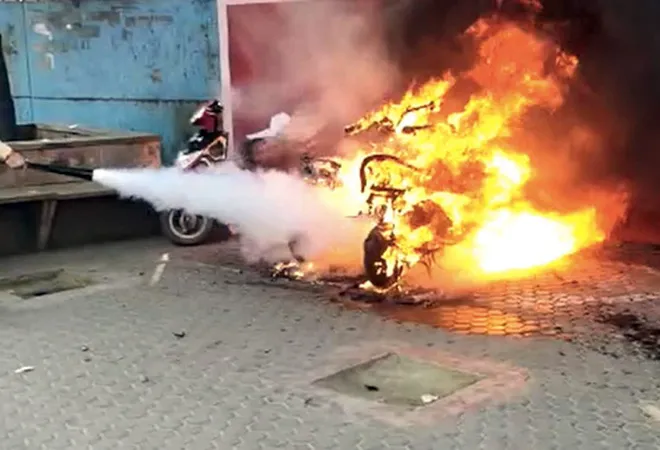
A spate of battery fires in electric two-wheelers across India has set alarm bells ringing, not just in the government but also in the entire electric two-wheeler industry. More importantly, these fires were noted across several different makes and models of electric two-wheelers, most recent ones being
Okinawa and
Ola. There is a genuine fear that such fires might lead to a panic amongst potential buyers, especially because some have led to fatalities, as was witnessed in the
recent incident, where a man and his daughter in Tamil Nadu died from smoke inhalation due to a fire that started from an electric two-wheeler plugged in for charging. This fear is not unfounded because the Indian automotive industry remembers what a
few fires due to faulty wiring did to the safety reputation of the Tata Nano.
How do these fires occur? Electric two-wheelers are largely powered by lithium-ion battery packs which consist of hundreds of individual battery cells. The most common cause of a battery fire is ‘thermal runaway’ in these cells. In this case, a positive feedback loop keeps the temperatures from rising in a single cell, and in a worst-case scenario, the increased pressure from the higher temperature leads to the cell splitting open and rapidly heating the surrounding cells. The hundreds of cells then have thermal runaway incidents of their own, leading to a full-fledged fire.
Electric two-wheelers are largely powered by lithium-ion battery packs which consist of hundreds of individual battery cells.
Lithium is amongst the lightest known metals, making it extremely suitable in applications where weight is vital. The idea of using lithium-ion batteries has been around for decades, but developing lithium-ion batteries into a workable form took decades. In 2019, scientists John B.Goodenough, M. Stanley Whittingham, and Akira Yoshino were awarded the Nobel Prize for Chemistry for their pioneering work in taming lithium and making it suitable to be used as a battery. Today, lithium batteries are all around us, from mobile phones and laptops to children’s toys, and now in electric vehicles of all shapes and sizes.
Despite the work done by these scientists and the industrialised mining of lithium and production of lithium cells, lithium batteries continue to be a problem. While some fault lies in substandard batteries, where pollutants amongst the other metals and components required for batteries can cause a problem, it would be fallacious to just blame ‘bad’ batteries. The experience with Samsung mobile phones and Sony Vaio laptops, which caught fire on planes and had top-notch lithium batteries, prove that under stress any lithium battery can pose a risk. But there is little doubt, that despite Bureau of Indian Standards (BIS) norms for batteries, poor quality batteries and chargers continue to be fitted on many of the electric two-wheelers that operate in India and can be disastrous. Many of these, particularly the low-speed two-wheelers, are made by companies with little or no manufacturing knowledge and are just put together from Chinese kits.
Thermal runaway, which can simply be explained as extreme overheating, can be contained at an early stage with adequate cooling and cell management. The latter is a route that many high-end applications of lithium batteries have adopted, not just on expensive cars but on high-end laptops and mobiles. These systems can monitor groups of cells for unusual activity and if temperatures start rising, that part of the battery pack gets automatically shut off from the rest of the system. In addition, better cooling systems can help electric vehicles cool themselves more efficiently. It is not surprising that many electrified performance vehicles have more intensive cooling systems than equivalent petrol-powered machines. However, both these solutions are expensive, and in the case of cooling systems, cumbersome as well. This is why a great majority of the electric two-wheelers in India sold today not only have lithium cells of questionable provenance but also are only air-cooled.
The latter is a route that many high-end applications of lithium batteries have adopted, not just on expensive cars but on high-end laptops and mobiles.
But these two conditions alone do not make a perfect storm; what makes this entire situation quite literally combustible is India’s hot climate. Batteries heat up while charging and while discharging. This can be noted in phones as well since they use lithium-ion batteries, albeit with slightly different chemistry to the batteries used in two-wheelers. One can feel the batteries heat up while making a long phone call. In the Apple iPhone or a high-end Android device, for example. if it gets too hot, it goes into a self-protect mode; it stops charging itself when the internal temperature of the device crosses a particular threshold.
Now, you can always tuck your phone away in your pocket very easily, but an electric two-wheeler that has been operating in India’s heat and dust? Not that easy, and even if you do find shade, ambient temperatures in parts of northern and central India in May and June can exceed 45 degrees Celsius, even at night. A battery that is charging or has just been used, maybe intensively, will find it impossible to cool down. If electric two-wheelers, particularly low-end products with questionable batteries and no thermal management systems proliferate, this can become a major problem. A problem that China faced in the early days of electric two-wheeler adoption in their country around 2016–2018, where electric vehicle fires were almost daily occurrences, particularly in hotter cities in interior China such as Chongqing.
However, all is not lost. Samsung repaired its reputation around the Galaxy device and made it extremely safe, despite airports and airlines constantly making announcements about the phone for a few years. Similarly, the portable laptop industry has worked on solutions such as cooling pads and crucially making their energy usage more efficient and thus not heating all that much. In addition, clever software and temperate sensors on devices prevent overheating and the potential for thermal runaway. Crucially, there will be a cost to these solutions, but if India’s decarbonisation has to work, we need to appreciate that we are a hot country and that heat has consequences for electric vehicles.
The strongest action would be to mandate a call back of all affected models till the most immediate issues are resolved.
Choosing safety over growth
The question is how can we ensure a growth path for electric two-wheelers that prioritises safety over blind growth? The electric mobility ecosystem, particularly two-wheelers, has evolved at an unprecedented pace.
Some projections suggest that production capacity for electric two-wheelers could increase to 30 million by 2026, up from less than half a million today. Such a rapid transition is likely to come at the cost of certain checks and balances that characterised the much steadier growth of the ICE ecosystem. However, it is this pace that threatens the long-term sustainability of this segment. The immediate action from the central government has been to set up a committee to probe the two fire incidents involving the Okinawa and Ola electric two-wheelers. It will be important to carry out these assessments impartially and make them the basis for a strong set of recommendations which Original equipment manufacturer (OEMs) must be mandated to follow with strict penalties for non-adherence. The strongest action would be to mandate a call back of all affected models till the most immediate issues are resolved. However, this will likely be an unpopular move considering that the government incentives have been a major driver of the increased uptake of these vehicles. Recently, the Department of Heavy Industries (DHI) increased the incentives provided to electric two-wheelers under the FAME-II scheme. The government will not want to take any drastic step which can hobble this segment.
More realistically, policymakers should now implement stronger monitoring systems to ensure that all vehicle batteries comply with existing standards. While the certification of a vehicle is based on a small sample set of vehicles, in reality, inconsistencies in the production process can lead to certain units being produced with inherent faults, especially if due diligence is sacrificed for the sake of faster production. Furthermore, standards need to be set for the increased adoption of the most effective cooling technologies. If this translates into higher vehicle costs it will still be worth it if it restores consumer confidence in these products.
Apart from government intervention, we can also hope that the manufacturers themselves will learn their lesson from this experience and rejig their approaches and practices. The focus should not be on who can achieve the largest production capacity, but on the safest production processes.
The views expressed above belong to the author(s). ORF research and analyses now available on Telegram! Click here to access our curated content — blogs, longforms and interviews.



 A spate of battery fires in electric two-wheelers across India has set alarm bells ringing, not just in the government but also in the entire electric two-wheeler industry. More importantly, these fires were noted across several different makes and models of electric two-wheelers, most recent ones being
A spate of battery fires in electric two-wheelers across India has set alarm bells ringing, not just in the government but also in the entire electric two-wheeler industry. More importantly, these fires were noted across several different makes and models of electric two-wheelers, most recent ones being  PREV
PREV



